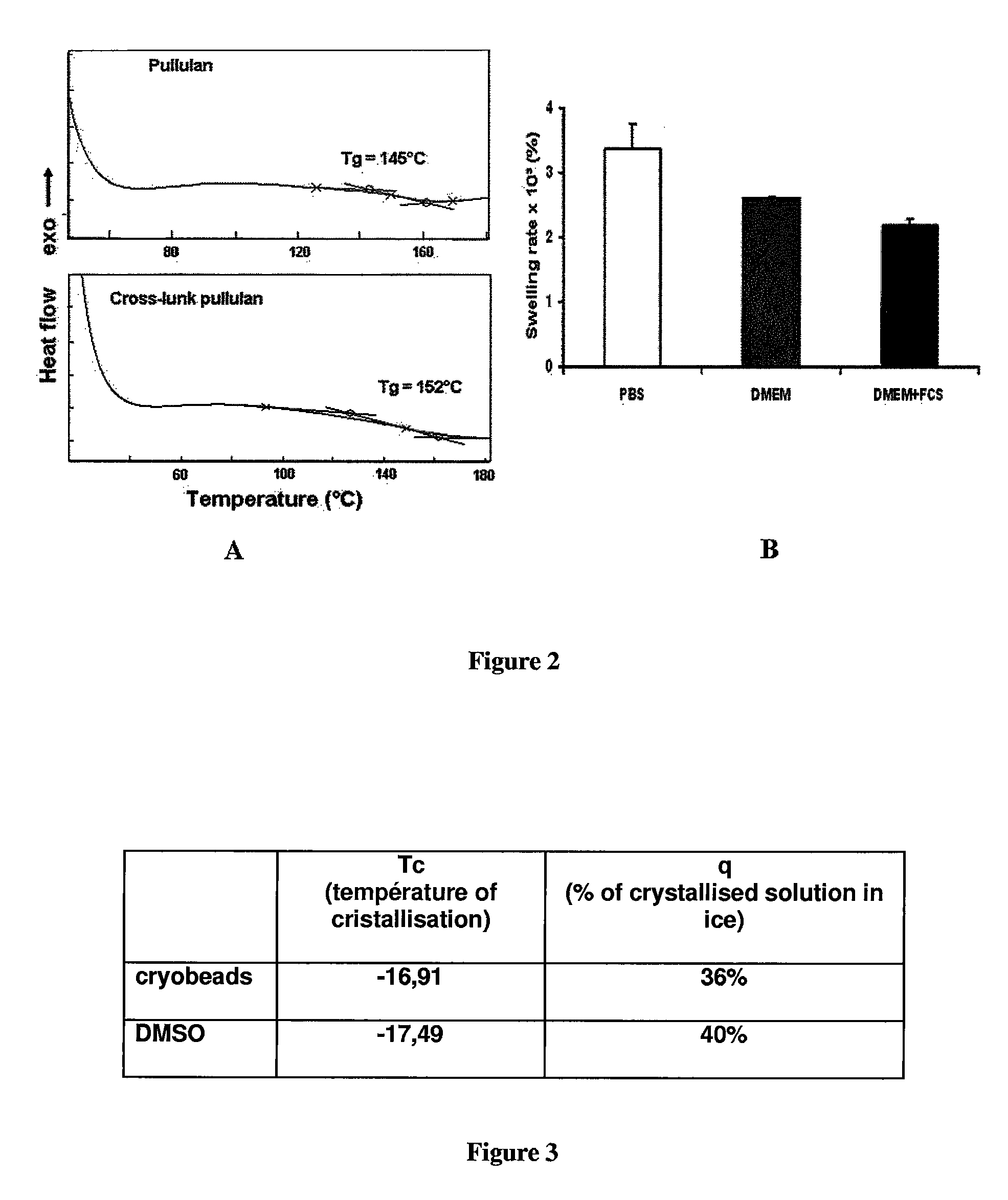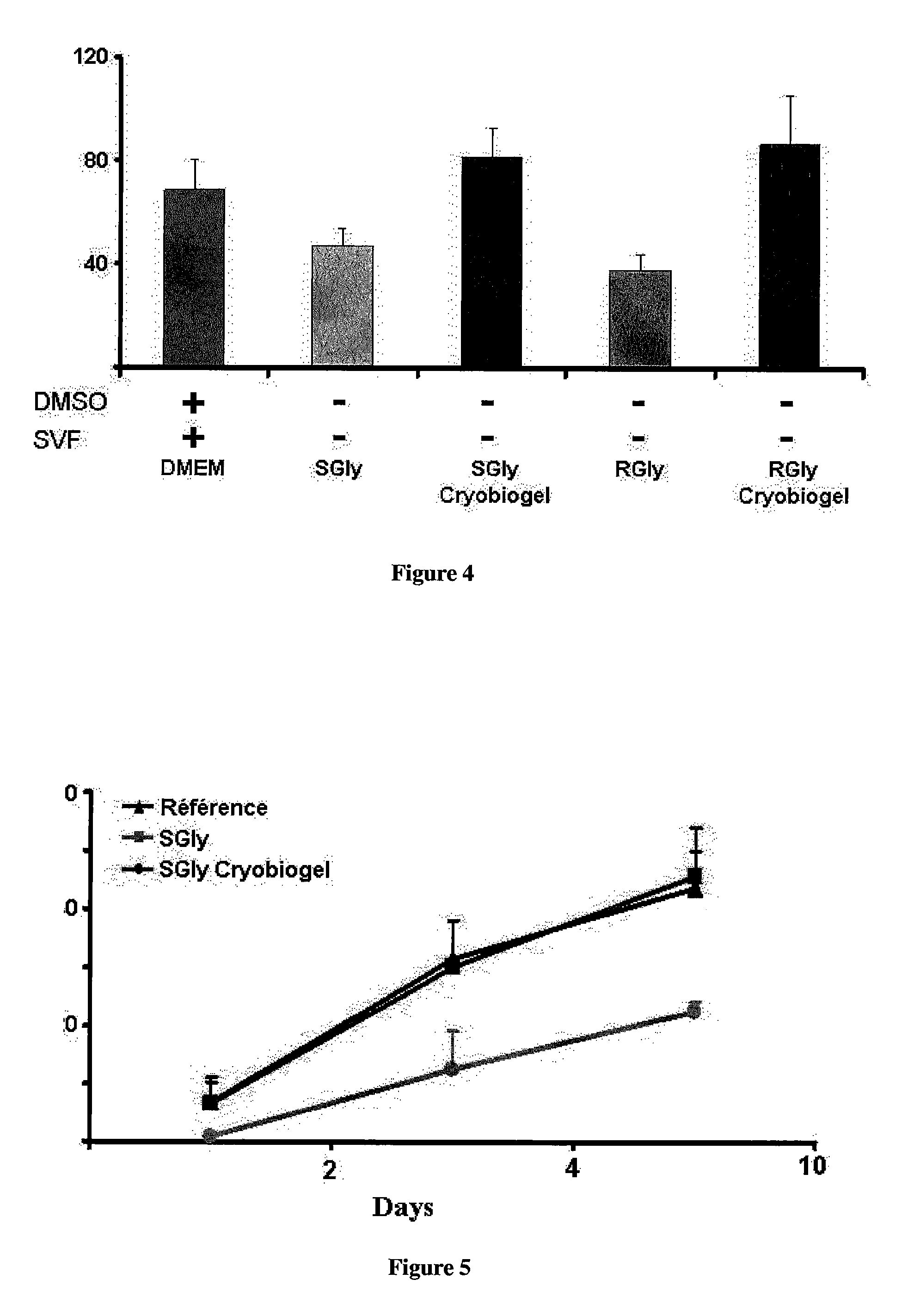Cryopreservation of cells, tissues and organs
a cryoprotectant and organ technology, applied in the field of cryoprotective of various cells, organs and tissues, can solve the problems of serious deleterious effect on cells, damage to cell walls and structures, damage to biological specimens, etc., and achieve the effects of avoiding or restricting the use of cryoprotectants, and limiting the risk of toxicity or genetic transformation
- Summary
- Abstract
- Description
- Claims
- Application Information
AI Technical Summary
Benefits of technology
Problems solved by technology
Method used
Image
Examples
example 1
Cells and Tissue Preservation
[0122]Polysaccharide based-hydrogel particles bank (Cryobiogel) was obtained by chemical crosslinking of pullulan (MW 200,000 Hayashibara, Okayama, Japan) with trisodium trimetaphosphate reticulating agent (STMP, 10% (w / w, Sigma)) under alkaline conditions at 50° C.
[0123]The resulting hydrogel was sieved on a strainer (5 mm in diameter), washed with a phosphate-buffered saline solution (PBS, pH 7.4) thoroughly rinsed in distilled water. Then, hydrogel was dehydrated in ethanol / water baths (one in 70%, two in 50% and three in absolute ethanol successively). After drying in vacuum at 50° C., the large particles were crushed and sieved to obtain calibrated hydrogel particles (ranging from 0.1 to 1.5 mm in diameter).
A) Cryobiogel Characterization
[0124]a) Protocols
Swelling Analysis
[0125]In order to define the behavior of the hydrogel particles in a physiological environment, swelling ratios of these hydrogels were determined in physiological serum. The weight...
example 2
Aortic Vessel Cryopreservation
[0153]Arterial specimens were placed in 2 ml liquid nitrogen storage vials for cryopreservation (Nuclon-Intermed, Nunc A / S, Roskildo, Denmark) containing the cryobiogel as cryoprotectant and cryopreservative medium or containing the control medium (DMEM, 10% FCS) with Dimethylsulphoxide (Me2SO) as the cryoprotectant. Next, the arterial segments were subjected to automated controlled freezing at a gradual temperature reduction rate of 1° C. / min to reach −80° C., and the segments were stored in the freezer at this temperature for a day. After this storage period, the segments were rapidly thawed by immersing in a water bath at 37° C. Excess medium was added and the aorta was easily recovered. The cryobiogel was removed by filtration.
[0154]FIG. 7 shows the cellular viability of[0155]a) fresh aortic vessel;[0156]b) aortic vessel in presence of DMSO;[0157]c) aortic vessel in presence of cryobiogel; and saline solution
[0158]The inventors showed that the proce...
example 3
Comparison of Swelling Properties Between the Hydrogels According to the Invention and Commercially Available Hydrogels Such as Agar® or Agargel®
[0159]The inventors showed that the hydrogel particle used in the context of the present invention is the only one offering very specific characteristic that allow it to be used in a cryopreservation process.
[0160]As shown in FIG. 8, the inventors compared the characteristics of the commercially available Agar®, Agargel® and Phytogel® and the hydrogel particles used in the context of the invention. After swelling, it appears that the viscosity of the hydrogel of the invention is higher, as shown in FIG. 9.
PUM
 Login to View More
Login to View More Abstract
Description
Claims
Application Information
 Login to View More
Login to View More - R&D
- Intellectual Property
- Life Sciences
- Materials
- Tech Scout
- Unparalleled Data Quality
- Higher Quality Content
- 60% Fewer Hallucinations
Browse by: Latest US Patents, China's latest patents, Technical Efficacy Thesaurus, Application Domain, Technology Topic, Popular Technical Reports.
© 2025 PatSnap. All rights reserved.Legal|Privacy policy|Modern Slavery Act Transparency Statement|Sitemap|About US| Contact US: help@patsnap.com



